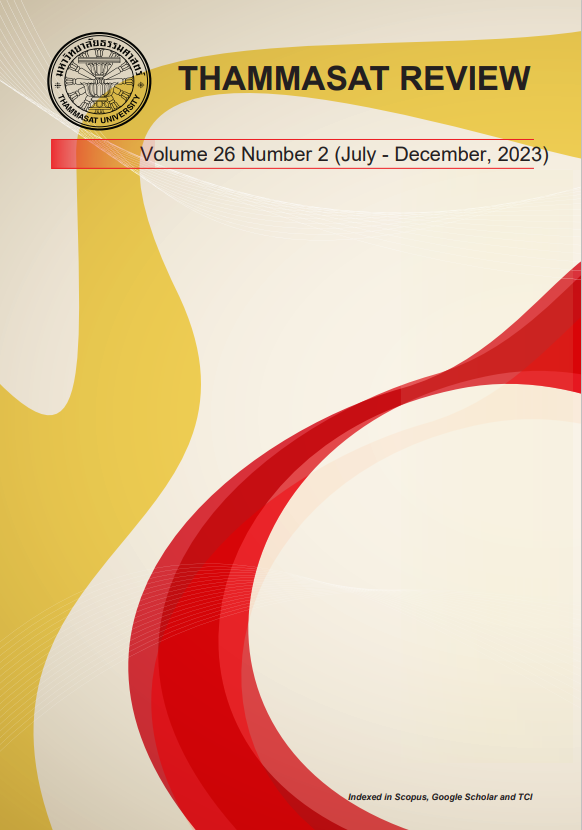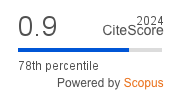Sectoral Integration in Disaster Risk Reduction (DRR) Investments: The Case of Myanmar and Philippines’ Financial Disaster Risk Response
Keywords:
Disaster risk reduction, Investments, Bottom-up, MyanmarAbstract
For decades, emergency plans of top-down, state-centered policies have been employed for disaster risk mitigation measures. These efforts undermine the importance of grassroots involvement in disaster governance, community-based initiatives, and resilience in terms of resource allocations and financial considerations. Hence, this paper tries to assess disaster risk reduction (DRR) investments in terms of structural and non-structural levels as mentioned in three dividends of DRR investment conceptualization. Further, it incorporates sectoral involvement in participatory budgeting, especially as framed by Integrated Community Based Risk Reduction (ICBRR), in building disaster resiliency at the substrate level. The study employed secondary data analysis, especially the latest inputs, through national and international sources, as a base year of calibration. By looking at the context of the Philippines and Myanmar–both being prone to extreme weather events and having climate-sensitive economic activities–the study rules out that while there are available DRR investments in both countries utilized for disaster mitigation, response, and rehabilitation, particularly in the frequent typhoon and flooding, it still has compelling gaps and consideration to augment response potentials. A bottom-up approach is necessary to empower local governments in both contexts and ensure the long-term impact of DRR financial considerations amidst unanticipated calamities.
References
Alasuutari, P., Brannen, J., & Bickman, L. (2008). The SAGE handbook of social research methods. The SAGE Handbook of Social Research Methods, 1-648.
Alcayna, T., Bollettino, V., Dy, P., & Vinck, P. (2016). Resilience and disaster trends in the Philippines: Opportunities for national and local capacity building. PLoS currents, 8.
Andutan, M. S. (2016). A research study in Myanmar seeks to identify crops with the lowest risk options for intensifying dryland cropping systems. https://ccafs.cgiar.org/news/ climate-smart-crops-myanmars-dry-regions#:~:text=Based%20on%20the%20initial%20SCF% 20in%202015%20in,green%20gram%20and%20chickpea%20in%20the%20post-rainy%20seasons.
Aung, S. (2010). National progress report on the implementation of the Hyogo Framework for Action (2009-2011) - interim. https://www.preventionweb.net/countries-regions/asia/ myanmar
Bartocci, L. (2016). Participatory Budgeting. University of Perugia, Perugia, Italy.
Berman, E. M., & Korosec, R. L. (2005). Planning to coordinate and coordinating the plan: Evidence from local governments. The American Review of Public Administration, 35(4), 380-401.
Braun, V., & Clarke, V. (2012). Thematic analysis. American Psychological Association.
Brennan, J. (2017). Against democracy. In Against Democracy. Princeton University Press.
Cadag, J. R. D., Petal, M., Luna, E., Gaillard, J. C., Pambid, L., & Santos, G. V. (2017). Hidden disasters: Recurrent flooding impacts on educational continuity in the Philippines. International journal of disaster risk reduction, 25, 72-81.
Carter, W. N. (2008). Disaster management: A disaster manager's handbook.
Cavallo E, Galiani S, Noy I, Pantano J. (2013). Catastrophic natural disasters and economic growth. Rev Econ Stat, 95(5):1549–1561.
Cebuana Lhuiller. (2016). 2016 Ready Disaster Resilience Forum: The role of Microinsurance in Building Disaster-Resilient Communities. https://www.cebuanalhuillier.com/2016-ready-disaster-resilience-forum-the-role-of-microinsurance-in-building-disaster-resilient-communities/
Center of Excellence in Disaster Management and Humanitarian Assistance. (2015). Philippines: Disaster Management Reference Handbook. Center for Excellence in Disaster Management and Humanitarian Assistance.
Climate Adaptation Forum. (2019). Changing Climate, Changing Health Strategies for Addressing Public Health in the Age of Climate Change. https://climateadaptationforum. org/wp-content/uploads/2019/07/Final-Agenda-Climate-Adaptation-Forum-Changing-Climate-Changing-Health.pdf
Chadha, P. (2020). The Four Phases of Crisis Management. https://agb.org/blog-post/the-four-phases-of-crisis-management/
Chapagain, D., Bharati, L., Mechler, R., Pflug, G., & Borgemeister, C. (2023). Understanding the role of climate change in disaster mortality: Empirical evidence from the Global South.
Citizens’ Disaster Response Center. (1991). Disaster: The Philippines Experience. CDRC, Quezon City.
Decker, F. (2008). Top-down vs. Bottom-up Budgeting, 2008. Review.
Dixon-Woods, M., Agarwal, S., Young, B., Jones, D., & Sutton, A. (2004). Integrative approaches to qualitative and quantitative evidence. London: Health Development Agency, 181.
Erdelj, M., Król, M., & Natalizio, E. (2017). Wireless sensor networks and multi-UAV systems for natural disaster management. Computer Networks, 124, 72-86.
Fossey, E., Harvey, C., McDermott, F., & Davidson, L. (2002). Understanding and evaluating qualitative research. Australian & New Zealand Journal of Psychiatry, 36(6), 717-732.
Given, L. M. (Ed.). (2008). The Sage encyclopedia of qualitative research methods. Sage publications.
Gitlin, L. N., & Fuentes, P. (2012). The Republic of Chile: an upper middle-income country at the crossroads of economic development and aging. The Gerontologist, 52(3), 297-305.
Habitat, UN (2007). Global report on human settlements 2007: Enhancing urban safety and security. Earthscan, London.
Howe, B., & Bang, G. (2017). Nargis and Haiyan: The politics of natural disaster management in Myanmar and the Philippines. Asian Studies Review, 41(1), 58-78.
Humanitarian Assistance and Resilience Programme Facility & the Myanmar Information Management Unit (HARPF-MIMU). (2018). Vulnerability in Myanmar: A Secondary Data Review of Needs, Coverage, and Gaps. https://themimu.info/sites/themimu.info/ files/documents/Report_Vulnerability_in_Myanmar_HARP-MIMU_Jun2018_ENG_ Online_version_low-res_0.pdf
Japan International Cooperation Agency (JICA). (2021). Flood risk protection project in Cavite inaugurated. https://www.jica.go.jp/philippine/english/office/topics/news/ 211001.html#:~:text=The%20Imus%20Retarding%20Basin%20has%20a%20holding%20capacity,volume%20of%20flood%20in%20Imus%20and%20Bacoor%20rivers
Kafle, S. K. (2010). Integrated community based risk reduction: an approach to building disaster resilient communities. In Annual International Workshop & Expo on Sumatra Tsunami Disaster & Recovery (pp. 1-20).
Kawasaki, A., Ichihara, N., Ochii, Y., Acierto, R. A., Kodaka, A., & Zin, W. W. (2017). Disaster response and river infrastructure management during the 2015 Myanmar floods: A case in the Bago River Basin. International Journal of Disaster Risk Reduction, 24, 151-159.
Kelman, I. (2014). No change from climate change: vulnerability and small island developing states. The Geographical Journal, 180(2), 120-129.
Khan, H., Vasilescu, L. G., & Khan, A. (2008). Disaster management cycle-a theoretical approach. Journal of Management and Marketing, 6(1), 43-50.
Laurent, O. (2015, 12 January). Haiti earthquake: Five years after. Time Magazine. http://time.com/3662225/haiti-earthquake-five-year-after/
Luna, E. M. (2001). Disaster mitigation and preparedness: the case of NGOs in the Philippines. Disasters, 25(3), 216-226.
Ministry of Natural Resources and Environmental Conservation (MONREC). (2019). Myanmar Climate Change Strategy (2018 – 2030).
Ministry of Planning, Finance, and Industry, Myanmar. (2021). Myanmar National Disaster Risk Financing Strategy. [Unpublished Manuscript]
Ministry of Social Welfare, Relief, and Resettlement. (2012). Myanmar Action Plan on Disaster Risk Reduction [MAPDRR].
Mochizuki, J.; Mechler, R.; Hochrainer-Stigler, S.; Keating, A.; Williges, K. (2014). Revisiting The ‘Disaster and Development’ Debate—Toward A Broader Understanding of Macroeconomic Risk and Resilience. Climate Risk Management.
Mulakala, A. (2016). Asian Approaches to Development Cooperation: Contemporary Asian Perspectives on South-South Cooperation.
Noji, E. (2005). Public Health Issues in Disasters. Crit. Care Med., 33, S29–S33.
Noy, I. (2009). The macroeconomic consequences of disasters. Journal of Development Economics, 88(2), 221-231.
Outhwaite, W., & Turner, S. (Eds.). (2007). The SAGE handbook of social science methodology. Sage.
Pacturan, (2016). Burma (Myanmar) and the Philippines can learn from each other. Inquirer.net. https://opinion.inquirer.net/86360/ph-and-burma-can-learn-from-each-other
Phellas, C. N. (2006). Keith F. Punch (2005). Introduction to Social Research—Quantitative & Qualitative Approaches. In Forum Qualitative Sozialforschung/Forum: Qualitative Social Research (Vol. 7, No. 2).
Przeworski, A., & Teune, H. (1966). Equivalence in cross-national research. Public Opinion Quarterly, 30(4), 551-568.
Raddatz C (2007) Are external shocks responsible for the instability of output in low-income countries? Journal of Development Economy, 84, 155–187.
Rey, A. (2015). TIMELINE: PH policies on climate change and disaster management. Rappler. https://www.rappler.com/environment/disasters/111307-climate-change-disaster-management-policies-philippines/
Shaw, R., & Team, I. E. D. M. (2009). Climate disaster resilience: focus on coastal urban cities in Asia. Asian Journal of Environment and Disaster Management, 1(1), 101-116.
Takasaki, Y. (2017). Do Natural Disasters Decrease The Gender Gap In Schooling? World Dev, 94, 75–89.
Tanner, T., e.al. (2018) The triple dividend of resilience : realizing development goals through the multiple benefits of disaster risk management (English). Washington, D.C.: World Bank Group. http://documents.worldbank.org/curated/en/993161515193991 394/The-triple-dividend-of-resilience-realizing-development-goals-through-the-multiple-benefits-of-disaster-risk-management
The Republic of the Union of Myanmar. (2012). The Environmental Conservation Law, The Pyidaungsu Hluttaw Law No. 9/ 2012 The 8th Waxing Day of Tagu, 1373 M. E.
The Republic of the Union of Myanmar. (2013). Natural Disaster Management Law (The Pyidaungsu Hluttaw Law No. 21,2013) The 9th waning of Waso,1375, M. E.
The Republic of the Union of Myanmar. (2015). The Ministry of Social Welfare, Relief and Resettlement Notification No. 22 / 2014 The 4 th Waning Day of Tagu, 1376, M.E.
Tun, M. M. (2020). FY2020 Country Report of Myanmar. Department of Disaster Management, Ministry of Social Welfare, Relief and Resettlement.
Ubungen, R. S., Ramos, V. B., & Casimiro, R. R. (2020). Analyzing bottom-up budgeting andassistance to disadvantaged municipalities program: toward participatory budget implementation in the first legislative district of nueva ecija in the philippines. Journal of Public Administration and Governance, 10(3), 288305
UN Convention to Combat Desertification. (2020). 2019 National Drought Plan for the Philippines. https://www.unccd.int/country-profile-document/philippines
UN OCHA. (2011). Myanmar: Natural Hazard Risks - National Hazard Map Issued: 22 March 2011. https://reliefweb.int/map/myanmar/myanmar-natural-hazard-risks-national-hazard-map-issued-22-march-2011
UN OCHA. (2011). Philippines: Natural Hazard Risks - National Hazard Map Issued: 01 March 2011. https://reliefweb.int/map/philippines/philippines-natural-hazard-risks-national-hazard-map-issued-01-march-2011
United Nations Office for the Coordination of Humanitarian affairs (OCHA). (2014). Myanmar Emergency Response Preparedness Plan (ERPP).
United Nations Office for Disaster Risk Reduction (UNDRR). (2011). Global assessment report on disaster risk reduction (2011). https://www.undrr.org/publication/global-assessment-report-disaster-risk-reduction-2011
United Nations Office for Disaster Risk Reduction (UNDRR). (2020). Disaster Risk Reduction in Myanmar Status Report 2020. https://www.undrr.org/media/48533/download? startDownload=true
Villacin, D. T. (2017). A review of Philippine government disaster financing for recovery and reconstruction. DISCUSSION PAPER SERIES NO. 2017-21
Wang, J.; Yang, J.; Li, B. (2017). Pain of Disasters: The Educational Cost of Exogenous Shocks Evidence from Tangshan Earthquake In 1976. China Econ. Rev., 46, 27–49.
Watson, J.; Gayer, M.; Connolly, M. (2007). Epidemics after Natural Disasters. Emerg. Infect. Dis., 13, 1–5.
World Bank. (2016). Disaster risk management overview. http://www.worldbank.org/ en/topic/disasterriskmanagement/overview#1
World Bank, Disaster Risk Financing Program. (2017). Disaster Risk Finance Country Diagnostic Note: Myanmar.
Yokomatsu, M., Mochizuki, J., Joseph, J., Burek, P., & Kahil, T. (2022). Macroeconomic co-benefits of DRR investment: assessment using the Dynamic Model of Multi-hazard Mitigation CoBenefits (DYNAMMICs) model. Disaster Prevention and Management: An International Journal, (ahead-of-print).
Downloads
Published
How to Cite
Issue
Section
License
Copyright (c) 2023 Thammasat Review

This work is licensed under a Creative Commons Attribution-NonCommercial-NoDerivatives 4.0 International License.
The opinions and ideas expressed in all submissions published in Thammasat Review are solely that of the author(s) and do not necessarily reflect that of the editors or the editorial board.
The copyright of all articles including all written content and illustrations belong to Thammasat Review. Any individuals or organisation wishing to publish, reproduce and distribute a particular manuscript must seek permission from the journal first.








